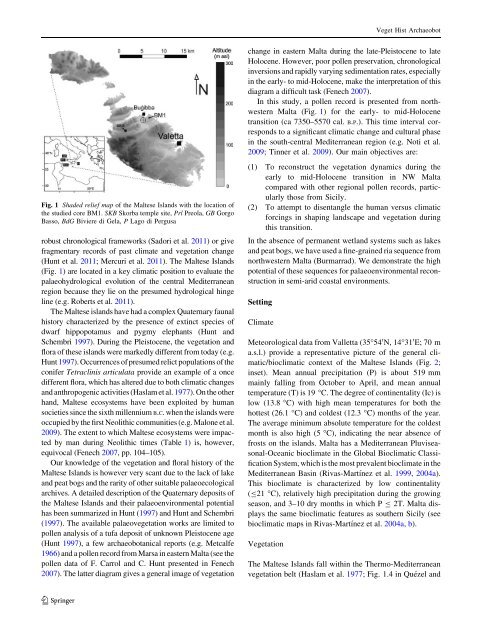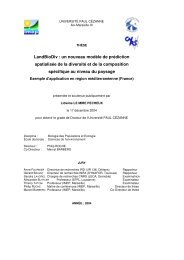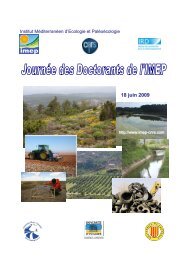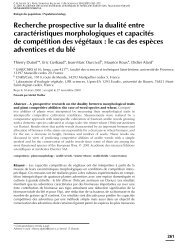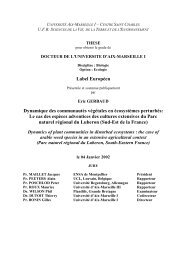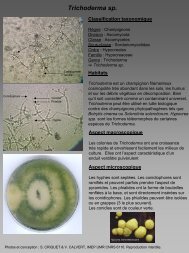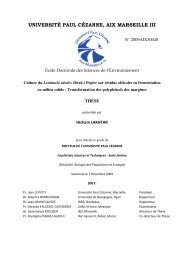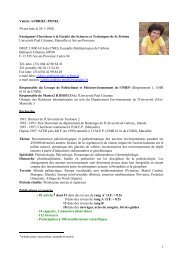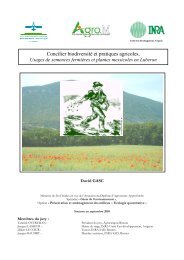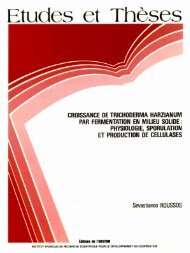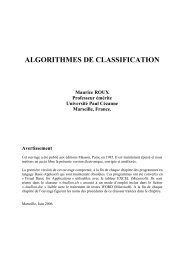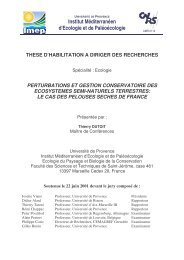Vegetation dynamics during the early to mid-Holocene ... - IMEP
Vegetation dynamics during the early to mid-Holocene ... - IMEP
Vegetation dynamics during the early to mid-Holocene ... - IMEP
Create successful ePaper yourself
Turn your PDF publications into a flip-book with our unique Google optimized e-Paper software.
Veget Hist Archaeobotchange in eastern Malta <strong>during</strong> <strong>the</strong> late-Pleis<strong>to</strong>cene <strong>to</strong> late<strong>Holocene</strong>. However, poor pollen preservation, chronologicalinversions and rapidly varying sedimentation rates, especiallyin <strong>the</strong> <strong>early</strong>- <strong>to</strong> <strong>mid</strong>-<strong>Holocene</strong>, make <strong>the</strong> interpretation of thisdiagram a difficult task (Fenech 2007).In this study, a pollen record is presented from northwesternMalta (Fig. 1) for <strong>the</strong> <strong>early</strong>- <strong>to</strong> <strong>mid</strong>-<strong>Holocene</strong>transition (ca 7350–5570 cal. B.P.). This time interval corresponds<strong>to</strong> a significant climatic change and cultural phasein <strong>the</strong> south-central Mediterranean region (e.g. Noti et al.2009; Tinner et al. 2009). Our main objectives are:Fig. 1 Shaded relief map of <strong>the</strong> Maltese Islands with <strong>the</strong> location of<strong>the</strong> studied core BM1. SKB Skorba temple site, Prl Preola, GB GorgoBasso, BdG Biviere di Gela, P Lago di Pergusarobust chronological frameworks (Sadori et al. 2011) or givefragmentary records of past climate and vegetation change(Hunt et al. 2011; Mercuri et al. 2011). The Maltese Islands(Fig. 1) are located in a key climatic position <strong>to</strong> evaluate <strong>the</strong>palaeohydrological evolution of <strong>the</strong> central Mediterraneanregion because <strong>the</strong>y lie on <strong>the</strong> presumed hydrological hingeline (e.g. Roberts et al. 2011).The Maltese islands have had a complex Quaternary faunalhis<strong>to</strong>ry characterized by <strong>the</strong> presence of extinct species ofdwarf hippopotamus and pygmy elephants (Hunt andSchembri 1997). During <strong>the</strong> Pleis<strong>to</strong>cene, <strong>the</strong> vegetation andflora of <strong>the</strong>se islands were markedly different from <strong>to</strong>day (e.g.Hunt 1997). Occurrences of presumed relict populations of <strong>the</strong>conifer Tetraclinis articulata provide an example of a oncedifferent flora, which has altered due <strong>to</strong> both climatic changesand anthropogenic activities (Haslam et al. 1977). On <strong>the</strong> o<strong>the</strong>rhand, Maltese ecosystems have been exploited by humansocieties since <strong>the</strong> sixth millennium B.C. when <strong>the</strong> islands wereoccupied by <strong>the</strong> first Neolithic communities (e.g. Malone et al.2009). The extent <strong>to</strong> which Maltese ecosystems were impactedby man <strong>during</strong> Neolithic times (Table 1) is, however,equivocal (Fenech 2007, pp. 104–105).Our knowledge of <strong>the</strong> vegetation and floral his<strong>to</strong>ry of <strong>the</strong>Maltese Islands is however very scant due <strong>to</strong> <strong>the</strong> lack of lakeand peat bogs and <strong>the</strong> rarity of o<strong>the</strong>r suitable palaeoecologicalarchives. A detailed description of <strong>the</strong> Quaternary deposits of<strong>the</strong> Maltese Islands and <strong>the</strong>ir palaeoenvironmental potentialhas been summarized in Hunt (1997) and Hunt and Schembri(1997). The available palaeovegetation works are limited <strong>to</strong>pollen analysis of a tufa deposit of unknown Pleis<strong>to</strong>cene age(Hunt 1997), a few archaeobotanical reports (e.g. Metcalfe1966) and a pollen record from Marsa in eastern Malta (see <strong>the</strong>pollen data of F. Carrol and C. Hunt presented in Fenech2007). The latter diagram gives a general image of vegetation(1) To reconstruct <strong>the</strong> vegetation <strong>dynamics</strong> <strong>during</strong> <strong>the</strong><strong>early</strong> <strong>to</strong> <strong>mid</strong>-<strong>Holocene</strong> transition in NW Maltacompared with o<strong>the</strong>r regional pollen records, particularlythose from Sicily.(2) To attempt <strong>to</strong> disentangle <strong>the</strong> human versus climaticforcings in shaping landscape and vegetation <strong>during</strong>this transition.In <strong>the</strong> absence of permanent wetland systems such as lakesand peat bogs, we have used a fine-grained ria sequence fromnorthwestern Malta (Burmarrad). We demonstrate <strong>the</strong> highpotential of <strong>the</strong>se sequences for palaeoenvironmental reconstructionin semi-arid coastal environments.SettingClimateMeteorological data from Valletta (35°54 0 N, 14°31 0 E; 70 ma.s.l.) provide a representative picture of <strong>the</strong> general climatic/bioclimaticcontext of <strong>the</strong> Maltese Islands (Fig. 2;inset). Mean annual precipitation (P) is about 519 mmmainly falling from Oc<strong>to</strong>ber <strong>to</strong> April, and mean annualtemperature (T) is 19 °C. The degree of continentality (Ic) islow (13.8 °C) with high mean temperatures for both <strong>the</strong>hottest (26.1 °C) and coldest (12.3 °C) months of <strong>the</strong> year.The average minimum absolute temperature for <strong>the</strong> coldestmonth is also high (5 °C), indicating <strong>the</strong> near absence offrosts on <strong>the</strong> islands. Malta has a Mediterranean Pluviseasonal-Oceanicbioclimate in <strong>the</strong> Global Bioclimatic ClassificationSystem, which is <strong>the</strong> most prevalent bioclimate in <strong>the</strong>Mediterranean Basin (Rivas-Martínez et al. 1999, 2004a).This bioclimate is characterized by low continentality(B21 °C), relatively high precipitation <strong>during</strong> <strong>the</strong> growingseason, and 3–10 dry months in which P B 2T. Malta displays<strong>the</strong> same bioclimatic features as sou<strong>the</strong>rn Sicily (seebioclimatic maps in Rivas-Martínez et al. 2004a, b).<strong>Vegetation</strong>The Maltese Islands fall within <strong>the</strong> Thermo-Mediterraneanvegetation belt (Haslam et al. 1977; Fig. 1.4 in Quézel and123


